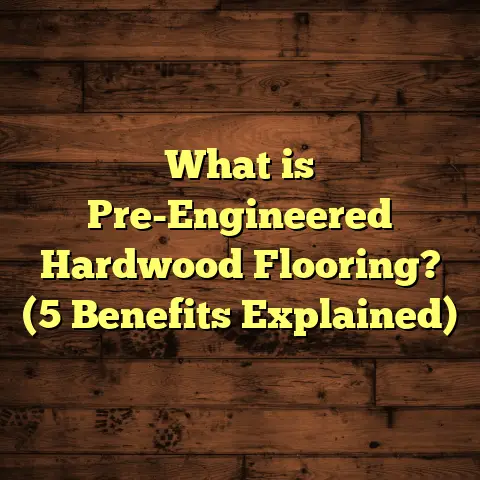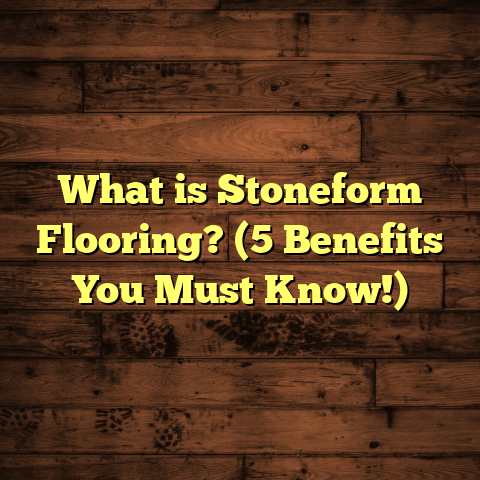What is Terrazzo Floor? (5 Benefits You Didn’t Know About!)
I want to tell you about a benefit of terrazzo floors that caught me completely off guard: their ability to blend timeless beauty with modern-day practicality. When I first encountered terrazzo in a renovation project, I was amazed by how this ancient flooring technique offered so much more than just looks. It’s tough, versatile, and surprisingly eco-friendly. If you’re hunting for flooring that stands the test of time and looks fantastic doing it, terrazzo might be the hidden gem you didn’t know about.
What is Terrazzo Floor?
Let me explain what terrazzo really is because the name alone doesn’t always tell the full story. Terrazzo is a type of flooring made by embedding small pieces of stone—marble, quartz, granite, or even glass—into a binding material. That binder can be cement-based (traditional terrazzo) or epoxy resin (modern terrazzo). After the mixture sets hard, the surface gets polished down to reveal a smooth, shiny finish dotted with colorful chips.
The word “terrazzo” means “terrace” in Italian, and its origins trace back hundreds of years to Venetian stoneworkers who wanted to reuse leftover marble bits instead of wasting them. This craft has evolved but still respects its roots by combining art and function in a single surface.
One of the cool things about terrazzo is its adaptability. Whether you want a subtle look with tiny white flecks or a bold, vibrant pattern featuring big chunks of colored glass, terrazzo can handle it. You’ll find it in classic buildings, modern airports, schools, hospitals, and increasingly in residential homes too.
How Terrazzo is Made
Understanding how terrazzo comes together helps appreciate why it’s such a durable and customizable material.
- Step 1: Preparing the Base
Typically, a concrete slab or subfloor acts as the base. For epoxy terrazzo, this can be applied over existing materials as well. - Step 2: Pouring the Binder
The binder—cement or epoxy—is poured onto the prepared surface. - Step 3: Adding Aggregates
Next, marble chips, glass pieces, or other aggregates are sprinkled or mixed into the binder while it’s still wet. - Step 4: Curing
The floor cures for several days until it hardens. - Step 5: Grinding and Polishing
Diamond grinding tools smooth out the surface and polish it until it shines. - Step 6: Sealing
A sealant is applied to protect against stains and moisture.
This process creates a single, seamless floor that can be tailored to almost any style preference.
5 Benefits of Terrazzo Floors You Didn’t Know About
Now that you know what terrazzo is, let me share five benefits that truly set it apart—ones I didn’t fully realize until I worked with it extensively.
1. Unmatched Durability and Longevity
If you want floors that will last decades without losing their charm, terrazzo is your answer. I’ve seen terrazzo floors in public buildings from the early 1900s still going strong today. That’s nearly 100 years of wear without needing replacement!
Here’s why terrazzo outlasts many other floors:
- The combination of stone chips and binder forms an incredibly strong surface.
- Unlike hardwood that dents or vinyl that cracks over time, terrazzo resists scratches and heavy foot traffic.
- According to data from the National Terrazzo & Mosaic Association, terrazzo floors last at least 40 years on average—often much longer—compared to hardwood’s 20-30 years and vinyl’s 10-15 years.
In one project I managed for a commercial lobby renovation, the existing terrazzo floor was over 60 years old but still structurally sound. We simply polished and resealed it instead of replacing. That saved thousands of dollars.
2. Minimal Maintenance Requirements
One of the best things about terrazzo is how easy it is to care for. When I switched my own kitchen floor to terrazzo, I quickly noticed how simple cleaning became. A quick sweep and damp mop keep it looking fresh—no need for harsh chemicals or repeated waxing like hardwood floors require.
Some points on maintenance:
- Terrazzo is non-porous when sealed properly, so it doesn’t soak up stains like carpet or unsealed stone.
- Regular cleaning with neutral pH cleaners maintains its shine without damage.
- No waxing or refinishing every few years, unlike hardwood or some tile grout lines.
- Resistant to mold and mildew, making it perfect for kitchens, bathrooms, and even outdoor areas if installed correctly.
From my experience working with clients who have pets or kids, terrazzo stands up to spills and dirt much better than softer flooring options. It’s also hypoallergenic, which means less dust buildup—a big plus if anyone in your home suffers from allergies.
3. Limitless Design Possibilities
Terrazzo isn’t just durable; it’s also incredibly versatile visually. The look can be subtle or bold—completely customizable depending on your taste.
Here’s how design options break down:
- Aggregates come in marble, glass, quartz, granite, even metals like brass or copper for unique effects.
- Chips can be large chunks or tiny specks for different textures.
- Binders vary in color—from classic gray cement to bright epoxy hues—that influence overall appearance.
- Patterns can range from simple monochrome mixes to intricate mosaics or logos embedded into the floor itself.
I remember one fun project where a local art museum wanted their logo embedded right into the lobby floor using bespoke blue and green glass chips mixed into epoxy terrazzo. The effect was stunning—a permanent piece of branding that’s also functional flooring.
Another time I helped design a mid-century-inspired home where we used terrazzo with earth-toned chips in random patterns that echoed vintage style but felt fresh and modern.
4. Eco-Conscious Flooring Choice
I’m always on the lookout for environmentally friendly materials for my projects. Terrazzo checks several boxes here:
- Often made from recycled aggregates like marble scraps or recycled glass bottles.
- Its long lifespan means fewer replacements and less waste over time compared to carpets or vinyl that wear out quickly.
- Cement-based terrazzo has a lower carbon footprint than many synthetic flooring materials.
- Some modern epoxy binders are formulated with low VOCs (volatile organic compounds), reducing indoor air pollution during installation.
For builders aiming at LEED certification or similar green building standards, terrazzo offers points toward sustainable design credits due to recycled content and durability.
In one project involving a green-certified office building, choosing terrazzo helped contribute to achieving their sustainability goals while giving them an elegant finish.
5. Excellent Thermal Performance
Here’s something many overlook: terrazzo floors have impressive thermal properties that can improve comfort and energy efficiency indoors.
Terrazzo has high thermal mass—that means it absorbs heat slowly during warmer parts of the day and releases it gradually when temperatures drop at night. This natural regulation can help reduce heating and cooling loads in your home or commercial space.
For example:
- In warm climates, terrazzo floors stay cool underfoot during hot days.
- Paired with radiant floor heating systems in colder areas, terrazzo evenly distributes heat across the surface for cozy warmth without cold spots.
In my experience working on a renovated historic library that installed radiant heating beneath its terrazzo floors, patrons commented on how comfortable the space felt year-round without blasting the central HVAC system constantly.
Cost Insights and How FloorTally Helps Me Manage Terrazzo Projects
You might be wondering about the price tag here because terrazzo isn’t known for being cheap upfront compared to carpet or vinyl. That’s true—it often runs between $20 and $50 per square foot depending on materials and complexity of design.
Still, considering its lifespan and low maintenance costs, it often evens out over time compared to cheaper floors that need replacing every decade or so.
When estimating costs for my projects, I rely heavily on FloorTally—a user-friendly online calculator that helps me break down all expenses related to flooring installation. It lets me input:
- Material types (cement vs epoxy binder)
- Aggregate preferences (marble chips vs glass)
- Labor rates based on local market conditions
- Waste factors to account for cutting offcuts or mistakes
By crunching these numbers early in project planning, I avoid surprises later and give clients realistic budgets upfront. For instance, FloorTally helped me quantify costs on a recent school gym floor renovation where we used epoxy terrazzo with custom colors—it showed total costs including labor would be roughly $35 per square foot with a standard 5% waste factor built-in.
Using tools like this saves time and ensures accuracy—helpful when quoting multiple flooring options side-by-side for clients deciding between terrazzo and polished concrete or tile alternatives.
Terrazzo Compared to Other Popular Flooring Options
Let’s take a closer look at how terrazzo compares to other common flooring types most people consider:
| Flooring Type | Durability | Maintenance | Design Flexibility | Typical Cost (per sq ft) | Environmental Impact |
|---|---|---|---|---|---|
| Terrazzo | Very high (40+ yrs) | Low | Very high | $20 – $50 | High (recycled content) |
| Hardwood | Moderate (15-25 yrs) | Moderate (refinishing needed) | Moderate | $8 – $15 | Moderate |
| Ceramic Tile | High | Moderate | High | $5 – $15 | Moderate |
| Vinyl | Low-moderate | Low | Moderate | $2 – $7 | Low |
| Carpet | Low (5-10 yrs) | High | Low | $3 – $8 | Low |
Durability: Terrazzo clearly wins here if you want something built to last generations without cracking or fading under heavy use.
Maintenance: Terrazzo’s sealed surface requires less upkeep than hardwood refinishing or carpet cleaning cycles.
Design: The endless chips and color combos make terrazzo a chameleon able to suit classic styles or ultra-modern aesthetics alike.
Cost: Upfront costs are higher but balanced out by decades of use without replacement expenses.
Environmental: Terrazzo’s use of recycled materials combined with longevity gives it an edge over synthetic options like vinyl carpeting which often end up in landfills faster.
Some Myths About Terrazzo Floors
I’ve heard lots of misconceptions about terrazzo over the years—let me clear some up:
- It’s only good for commercial spaces: False. While common in public buildings due to durability, residential terrazzo installations are growing rapidly because of style flexibility and longevity.
- It’s cold and hard underfoot: True that it’s hard surface—but pairing it with radiant heating solves comfort issues easily. Plus, rugs can add coziness anywhere needed.
- Installation takes forever: Modern epoxy terrazzo systems can install much faster than traditional cement-based ones—sometimes completed within days for standard rooms instead of weeks.
Personal Stories from My Flooring Adventures
I want to share some stories from my own work with terrazzo:
At one point early in my career, I worked on restoring an old theater downtown that had original terrazzo floors covered by decades of carpet and dirt. After stripping everything away and polishing up the original surface beneath, we revealed stunning geometric patterns dating back to the 1920s. The owners were thrilled—and it saved them tens of thousands compared to replacement flooring.
Another time I helped a family switch from tile to epoxy terrazzo in their beach house kitchen. They loved how spill cleanup was easier with kids around plus the floor stayed cool even during hot summer days—a perfect fit for coastal living.
These experiences taught me that terrazzo is not just about function; it’s about preserving history while supporting modern lifestyles.
Installation Tips for Terrazzo Floors
If you’re thinking about installing terrazzo at home or work, here are some tips from my experience:
- Hire experienced installers: Terrazzo installation requires skillful grinding and polishing; cutting corners leads to uneven surfaces or dull finishes.
- Choose the right binder: Epoxy gives vibrant colors and faster curing times but may not suit outdoor spaces exposed to UV light; cement-based works better outdoors but takes longer to cure.
- Plan your design carefully: Work with designers early on if you want patterns or logos embedded—the earlier you plan, the easier implementation becomes.
- Prep your subfloor well: Proper leveling ensures longevity and prevents cracking later on.
Caring for Your Terrazzo Floor Over Time
Once installed, keeping your terrazzo floor looking sharp isn’t complicated:
- Sweep regularly to avoid grit scratching surface.
- Mop with pH-neutral cleaners—avoid acidic or abrasive products.
- Periodically reapply sealants every few years based on wear levels.
- Use mats at entryways to catch dirt before it hits your floor.
From my projects monitoring maintenance schedules over decades, these routines keep floors shining without costly repairs.
Can Terrazzo Work Outdoors?
Yes! Outdoor terrazzo installations are possible but require some considerations:
- Cement-based binders are preferred as epoxy can yellow under UV exposure.
- Choose aggregates resistant to freeze-thaw cycles if you live in cold climates.
- Sealants must be suitable for exterior conditions providing slip resistance too.
I’ve worked on outdoor patios using cementitious terrazzo that performed beautifully even after years exposed to sun and rain.
Frequently Asked Questions About Terrazzo Flooring
Q: How long does it take to install terrazzo?
A: It depends on floor size and binder type—cement-based may take weeks due to curing; epoxy systems install faster (a few days for typical rooms).
Q: Is terrazzo slippery?
A: When polished smooth it can be slippery when wet; sealants with anti-slip additives help mitigate this risk especially in bathrooms or kitchens.
Q: Can I install terrazzo over existing floors?
A: Epoxy terrazzo can sometimes be applied over concrete slabs or tiles if surface prep is done right; cement-based generally requires new base layer poured.
Q: What colors are available?
A: Thousands of options exist thanks to varied aggregates and binder colors—you can customize practically any palette imaginable.
I hope this gives you a thorough understanding of what terrazzo floors are all about—from their history and construction to lesser-known benefits like thermal performance and sustainability. Over years working hands-on with clients across homes and commercial projects, I’ve found terrazzo combines beauty with unmatched durability better than almost any other material out there.
If you have questions about whether terrazzo fits your space or want advice on installation tips based on your budget and style goals—just ask! I love chatting about flooring options because picking the right floor changes how you live every day—and terrazzo might be just what you need without realizing it yet.





